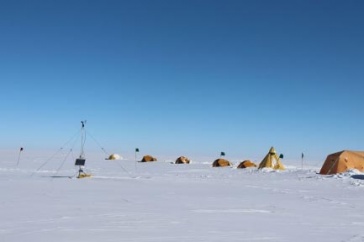UNH Researchers Participate in NSF-Funded Antarctica Deep Ice Core Drilling

UNH project managers will provide logistics and science support planning for researchers who will live in tents on the Hercules Dome ice sheet hundreds of miles from any inhabited areas similar to this camp from 2019 to 2020. Credit: Gemma O’Connor/University of Washington
DURHAM, N.H.— Scientists from the University of New Hampshire have received a five-year, $425,000 grant from the National Science Foundation to plan logistics for retrieving environmental samples in ice that could unlock the secrets of Earth’s last warm period and help with future climate change projections.
Research Project Managers Joe Souney and Mark Twickler will be part of a multi-institutional U.S. team that will drill down to ice from 130,000 years ago at Hercules Dome, a location hundreds of miles from the Antarctica coastline near the South Pole and a promising site that could provide possible clues to the last collapse of the West Antarctic Ice Sheet.
“By drilling down into the ice sheet and recovering these cylinders of ice from ancient times, it allows us to look back in time for thousands and thousands of years and determine what the climate conditions were like back then,” said Souney.
The Hercules Dome site, remote even by Antarctic standards, lies near a mountain range that divides east and west Antarctica. The site itself is approximately 8,200 feet above sea level with a mean average temperature of -35 degrees Fahrenheit. When snow falls in Antarctica’s interior it rarely melts, and instead builds up in thick layers, which are compressed into ice by subsequent snowfall. The ice layers contain dissolved chemicals, insoluble dust particles and atmospheric gases that were present when the snow fell. Ice and air bubbles trapped in the ice layers can provide researchers with information about past conditions.
“The ice cores from this region should provide the most detailed Eemian epoch environmental record available pretty much anywhere in the world,” said Twickler. “The Eemian epoch, which was about 120,000–130,000 years ago, was the last time the Earth was in a warm period similar to today. If we can better understand the environmental drivers then, it might help us better understand current climatic conditions and help predict future conditions.”
The UNH project managers will provide logistics and science support planning for the field project. Researchers will live in tents on the ice sheet hundreds of miles from any inhabited areas for the months-long field seasons.
“Our planning will detail, for example, how we will get ourselves and all of the required science cargo and camp materials to Hercules Dome, likely through a combination of overland traverse and aircraft support; specifics on the field camp, such as camp population, camp structures and layout, power and fuel requirements, camp equipment; and the fieldwork schedule,” said Souney.
The National Science Foundation funded the roughly five-year, $3 million project involving the University of New Hampshire, the University of Washington, the University of California, Irvine and the University of Minnesota. Work has been delayed by the novel coronavirus but drilling the 1.5-mile ice core is set to begin in 2024.
The University of New Hampshire inspires innovation and transforms lives in our state, nation, and world. More than 16,000 students from all 50 states and 71 countries engage with an award-winning faculty in top-ranked programs in business, engineering, law, health and human services, liberal arts and the sciences across more than 200 programs of study. As one of the nation’s highest-performing research universities, UNH partners with NASA, NOAA, NSF and NIH, and receives more than $110 million in competitive external funding every year to further explore and define the frontiers of land, sea and space.
IMAGES AVAILABLE FOR DOWNLOAD
https://unh.edu/unhtoday/sites/default/files/media/nsf1.jpg
Caption: The new ice core will be drilled at Hercules Dome at 86 degrees South, about 400 kilometers (250 miles) from the South Pole and 1,000 km (650 miles) from today’s coastline. This map shows the sites of previously drilled Antarctic ice cores.
Credit: University of Washington
https://unh.edu/unhtoday/sites/default/files/media/nsf2.jpg
Caption: An aerial view of a field camp shows the researchers’ tents (black dots) on a flat expanse of snow-covered ice. Hercules Dome is a gradual rise on a flat part of the ice sheet, out of view of the nearby Transantarctic Mountains.
Credit: Gemma O'Connor/University of Washington
https://unh.edu/unhtoday/sites/default/files/media/nsf3.jpg
Caption: Researchers camped in tents for three weeks in Hercules Dome in 2019 to 2020, using the black panel on the left for satellite communication and a generator for power. The surrounding snow provides water and refrigeration.
Credit: Gemma O’Connor/University of Washington
Latest News
-
November 6, 2025
-
November 5, 2025
-
October 24, 2025
-
October 8, 2025
-
October 2, 2025
















































